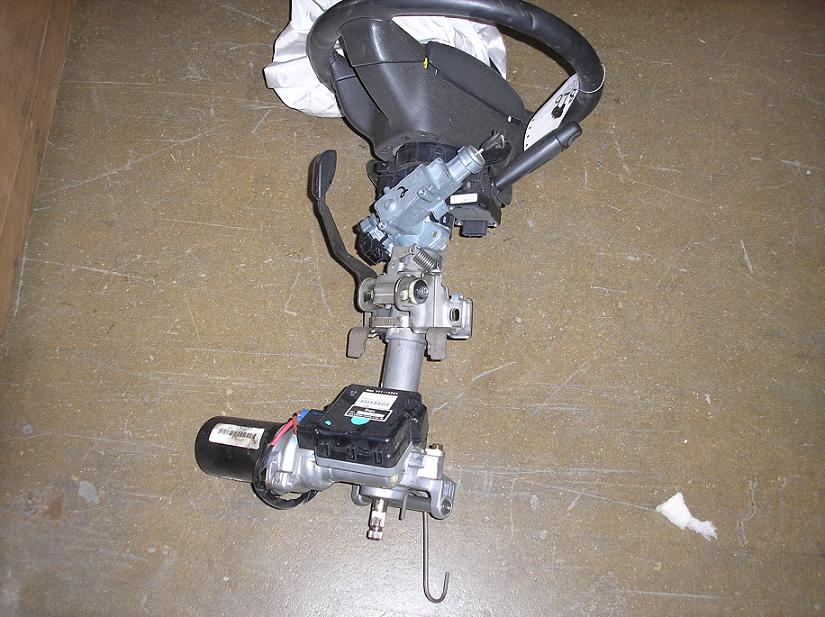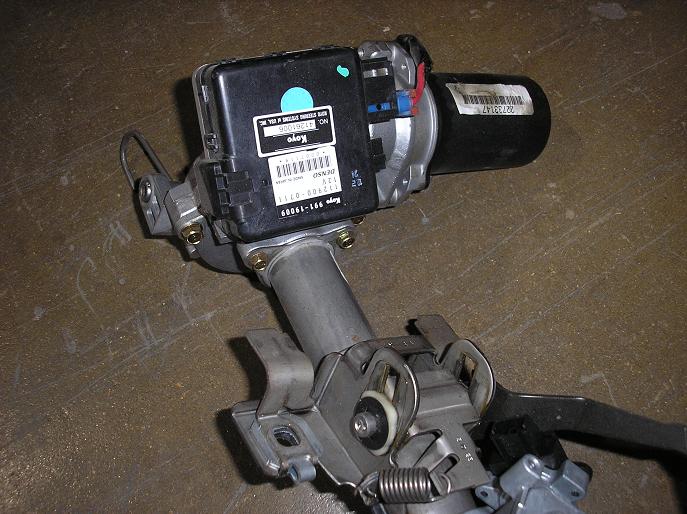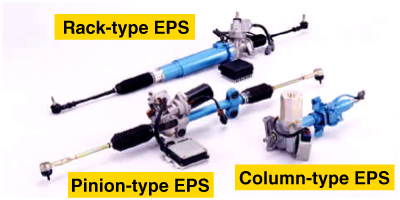
FastFieros is working hard on a EPS system for the Fiero..


Saturn removed the hydraulic power steering pump. Saturn chose a Koyo-supplied electronic power steering unit that is speed-sensitive, has an integrated torque sensor, and is said to provide an fuel savings of 0.7 mpg. "There are five different calibrations for the steering," says GM spokes person, "which correspond to the wheel and tire combinations offered on the sedan and coupe." There are, he admits, three more calibrations available. Storck declined to identify what changes to the Ion's specs would trigger their use.
| Type of EPS (Electric power steering) |

| Power steering system types and characteristics | |
| Electric Power Steering (EPS) | |
| Column-assist type | -The power
assist unit, controller and torque sensor are attached to the steering
column. -This system is compact and easy to mount on the vehicle. -This power assist system can be applied to fixed steering columns, tilt-type steering columns and other column types. |
 |
|
| Pinion-assist type | -The power
assist unit is attached to the steering gear's pinion shaft. -The power assist unit is outside the vehicle's passenger compartment, allowing assist torque to be increased greatly without raising interior noise. -Combined with a variable-ratio steering gear, this system can suffice with a compact motor and offer superior handling characteristics. |
 |
|
| Rack-assist type | -The power
assist unit is attached to the steering gear rack. -The power assist unit can be located freely on the rack, allowing great flexibility in layout design. -The power assist unit's high reduction gear ratio enables very low inertia and superior driving feeling. |
 |
|
| Direct-drive type | -The
steering gear rack and power assist unit form a single unit. -The steering system is compact and fits easily in the engine compartment layout. -The direct provision of assistance to the rack enables low friction and inertia, and in turn ideal steering feeling. |
 |
|
| Hydraulic-Electric Power Steering (H-EPS) | |
| Hydraulic power steering with motor-driven pump |
-Microcomputer control of the electric motor driving the pump allows
this hydraulic power steering system to achieve great energy savings. -The motor, pump, reservoir and controller compose a single unit, making installation easy and nearly eliminating the need for tubing adjustments after attachment. -The hydraulic pump is driven by a high-performance brushless motor, enabling both energy savings and a quick response. |
 |
|
| Normal Hydraulic Power Steering | |
| Electronically controlled hydraulic power steering | -This
system offers both high power and a smooth steering feeling. -Application on a wide range of vehicles from compact cars to trucks is possible. -Electronic control by computer enables performance corresponding to vehicle speed and an ideal steering feeling. |
 |
|
| Koyo Seiko, Toyoda Machine Works, DENSO and TMC Tie Up on Electric/Electric Hydraulic Power Steering Systems |
| —New Joint Venture to Aim at Becoming World Leader— |
| Tokyo—KOYO SEIKO CO., LTD (Koyo Seiko), TOYODA MACHINE WORKS, LTD.
(Toyoda Machine Works), DENSO CORPORATION (DENSO) and TOYOTA MOTOR
CORPORATION (TMC) announced today that they plan to establish on Nov. 1,
2002, a joint venture that will specialize in the development and sales
of electric power steering and electric-hydraulic power steering systems
(collectively known as "EPS"). FAVESS Co., Ltd. (FAVESS), which will be located in Aichi Prefecture and headed by a president to be appointed by Koyo Seiko, will concentrate the resources and technology of its four founding companies with an aim to become the world's leading supplier of EPS and related products. EPS, which contributes to greater automobile fuel efficiency and allows a higher level of control than in conventional hydraulic power steering systems, is seen as playing a key role in making cars more environmentally considerate and in meeting the growing demand among automakers for advanced automotive control technology. In view of its benefits, automakers, first in Europe and then in Japan, the United States and elsewhere, have been increasingly turning to EPS. Although initially limited to small vehicles, EPS is now being applied to midsize and larger vehicles, with demand expected to increase significantly. Koyo Seiko, Toyoda Machine Works, DENSO and TMC intend to respond to market needs and gain the confidence of all automakers through FAVESS by quickly and efficiently developing next-generation EPS systems with advanced, innovative technology. FAVESS will mainly focus on the following six activities:
|
|
|
News Releases |
|
|
|
| September 1, 2000 | |
| Koyo Seiko Co., Ltd. Toyoda Machine Works, Ltd. |
| Koyo Seiko Co., Ltd., and Toyoda
Machine Works, Ltd., have reached a basic agreement to carry out
joint development of electric power steering (EPS). Koyo Seiko and
Toyoda Machine Works are both world-class integrated steering system
manufacturers that aggressively carry out the development of
innovative steering products. The demand worldwide for environmentally friendly steering systems has risen dramatically in recent years and is bringing about a rapid shift from hydraulic power steering to EPS. The energy consumption of EPS is a mere one-sixth that of hydraulic systems, making EPS very effective in resource conservation. It is predicted that in 2005 more than 30% of the world's cars, or about 20 million vehicles, will be equipped with EPS. The two companies decided to combine their technological capabilities and development resources in relation to EPS in order to respond with increased speed and efficiency to the demand from society for energy-efficient steering products. They believe that such a joint development program will enable the development of EPS systems with superior performance, quality, cost and size and allow the companies to respond quickly to the needs of customers and provide world-leading products. Specifically, the following will be carried out as part of this joint development program. ・ Technology exchanges ・ Personnel exchanges ・ Sharing of development resources (to eliminate overlap) ・ Improvement of development efficiency through promotion of standardization |
| Outline of Koyo Seiko |
| Company name: | Koyo Seiko Co., Ltd. |
| Main business activities: | Manufacture and sales of bearings, steering products and other products |
| Established: | January 18, 1921 |
| Head office: | No.5-8, Minamisemba 3-chome, Osaka, Japan |
| Representative: | Hiroshi Inoue, president |
| Capital: | 25,893 million yen |
| Employees: | 6,974 |
| Outline of Toyoda Machine Works |
| Company name: | Toyoda Machine Works, Ltd. |
| Main business activities: | Manufacture and sales of machine tools, auto parts and other products |
| Established: | May 1, 1941 |
| Head office: | No.1-1, Asahimachi, Kariya-shi, Aichi Prefecture |
| Representative: | Takao Yunokawa |
| Capital: | 24,805 million yen |
| Employees: | 4,272 |
The electric power steering (EPS) system reduces the amount of effort needed to steer the vehicle. The system uses the body control module (BCM), power steering control module (PSCM), torque sensor, discrete battery voltage supply circuit, EPS motor, serial data bus, and the instrument panel cluster (IPC) message center to perform the system functions. The PSCM, torque sensor, not the EPS motor are serviced separately from each other or from the steering column. Any EPS components diagnosed to be malfunctioning requires replacement of the steering column assembly, also known as the EPS assembly.
The PSCM uses a torque sensor as it's main input for determining the amount of steering assist. The steering column has an input shaft, from the steering wheel to the torque sensor, and an output shaft, from the torque sensor to the steering shaft coupler. The input and output shafts are separated by a torsion bar, where the torque sensor is located. The sensor consists of a compensation coil, detecting coil and 3 detecting rings. These detecting rings have toothed edges that face each other. Detecting ring 1 is fixed to the output shaft, detecting rings 2 and 3 are fixed top the input shaft. The detecting coil is positioned around the toothed edges of detecting rings 1 and 2. As torque is applied to the steering column shaft the alignment of the teeth between detecting rings 1 and 2 changes, which causes the detecting coil signal voltage to change. The PSCM recognizes this change in signal voltage as steering column shaft torque. The compensation coil is used to compensate for changes in electrical circuit impedance due to circuit temperature changes from the electrical current and voltage levels as well as ambient temperatures for accurate torque detection.
The EPS motor is a 12 volt brushed DC reversible motor with a 58 amp rating. The motor assists steering through a worm shaft and reduction gear located in the steering column housing.
The PSCM uses a combination of torque sensor inputs, vehicle speed, calculated system temperature and the steering calibration to determine the amount of steering assist. When the steering wheel is turned, the PSCM uses signal voltage from the torque sensor to detect the amount of torque being applied to the steering column shaft and the amount of current to command to the EPS motor. The PSCM receives serial data from the engine control module (ECM) to determine vehicle speed. At low speeds more assist is provided for easy turning during parking maneuvers. At high speeds, less assist is provided for improved road feel and directional stability. The PSCM nor the EPS motor are designed to handle 58 amps continuously. The PSCM will go into overload protection mode to avoid system thermal damage. In this mode the PSCM will limit the amount of current commanded to the EPS motor which reduces steering assist levels. The PSCM also chooses which steering calibration to use when the ignition is turned ON, based on the production map number stored in the BCM. The PSCM contains all 8 of the steering calibrations which are different in relation to the vehicles RPO's. The PSCM has the ability to detect malfunctions within the EPS system. Any malfunction detected will cause the IPC message center to display PWR STR (or Power Steering) warning message.